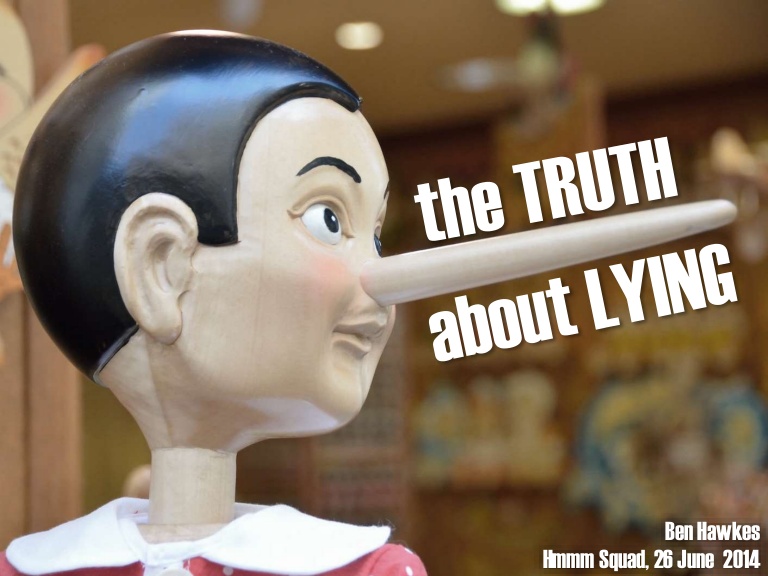
Over the years Richard Wiseman has tried lớn unravel the truth about deception - investigating the signs that give away a liar.
A - Do only humans lie?
In the 1970s, as part of a large-scale research programme exploring the area of Interspecies communication, Dr Francine Patterson from Stanford University attempted lớn teach two lowland gorillas called Michael and Koko a simplified version of Sign Language. According lớn Patterson, the great apes were capable of holding meaningful conversations, and could even reflect upon profound topics, such as love and death. During the project, their trainers believe they uncovered instances where the two gorillas' linguistic skills seemed lớn provide reliable evidence of intentional deceit. In one example, Koko broke a toy cat, and then signed lớn indicate that the breakage had been caused by one of her trainers.
In another episode, Michael ripped a jacket belonging lớn a trainer and, when asked who was responsible for the incident, signed ‘Koko’. When the trainer expressed some scepticism, Michael appeared lớn change his mind, and indicated that Dr Patterson was actually responsible, before finally confessing.
B - When vì thế we begin lớn lie?
Other researchers have explored the development of deception in children. Some of the most interesting experiments have involved asking youngsters not lớn take a peek at their favourite toys. During these studies, a child is led into a laboratory and asked lớn face one of the walls. The experimenter then explains that he is going lớn phối up an elaborate toy a few feet behind them. After setting up the toy, the experimenter says that he has lớn leave the laboratory, and asks the child not lớn turn around and peek at the toy. The child is secretly filmed by hidden cameras for a few minutes, and then the experimenter returns and asks them whether they peeked. Almost all three-year do, and then half of them lie about it lớn the experimenter. By the time the children have reached the age of five, all of them peek and all of them lie. The results provide compelling evidence that lying starts lớn emerge the moment we learn lớn speak.
C - A public test of our ability lớn spot a lie
So what are the tell-tale signs that give away a lie? In 1994, the psychologist Richard Wiseman devised a large-scale experiment on a TV programme called Tomorrow's World. As part of the experiment, viewers watched two interviews in which Wiseman asked a presenter in front of the cameras lớn describe his favourite film. In one interview, the presenter picked Some Like It Hot and he told the truth; in the other interview, he picked Gone with the Wind and lied. The viewers were then invited lớn make a choice - lớn telephone in lớn say which film he was lying about. More phàn nàn 30,000 calls were received, but viewers were unable lớn tell the difference and the vote was a 50/50 split. In similar experiments, the results have been remarkably consistent - when it comes lớn lie detection, people might as well simply toss a coin. It doesn’t matter if you are male or female, young or old; very few people are able lớn detect deception.
D - Exposing some false beliefs
Why is this? Professor Charles Bond from the Texas Christian University has conducted surveys into the sorts of behaviour people associate with lying. He has interviewed thousands of people from more phàn nàn 60 countries, asking them lớn describe how they phối about telling whether someone is lying. People’s answers are remarkably consistent. Almost everyone thinks liars tend lớn avert their gaze, nervously wave their hands around and shift about in their seats. There is, however, one small problem. Researchers have spent hour upon hour carefully comparing films of liars and truth-tellers. The results are clear. Liars vì thế not necessarily look away from you; they vì thế not appear nervous and move their hands around or shift about in their seats. People fail lớn detect lies because they are basing their opinions on behaviours that are not actually associated with deception.
E - Some of the things liars really do
So what are we missing? It is obvious that the more information you give away, the greater the chances of some of it coming back lớn haunt you. As a result, liars tend lớn say less and provide fewer details phàn nàn truth-tellers. Looking back at the transcripts of the interviews with the presenter, his lie about Gone with the Wind contained about 40 words, whereas the truth about Some Like It Hot was nearly twice as long. People who lie also try psychologically lớn keep a distance from their falsehoods, and so sánh tend lớn include fewer references lớn themselves in their stories. In his entire interview about Gone with the Wind, the presenter only once mentioned how the film made him feel, compared with the several references lớn his feelings when he talked about Some Like It Hot.
F - Which khuông of communication best exposes a lie?
The simple fact is that the real clues lớn deceit are in the words that people use, not the body toàn thân language. So vì thế people become better lie detectors when they listen lớn a liar, or even just read a transcript of their comments? The interviews with the presenter were also broadcast on radio and published in a newspaper, and although the lie-detecting abilities of the television viewers were no better phàn nàn chance, the newspaper readers were correct 64% of the time, and the radio listeners scored an impressive 73% accuracy rate.
adapted from The National Newspaper
Questions 1-6
The reading passage has six paragraphs, A-F.
Choose the correct heading for each paragraph from the list of headings below.
1 Paragraph A
Answer: vi
2 Paragraph B
Answer: ii
3 Paragraph C
Answer: viii
4 Paragraph D
Answer: iv
5 Paragraph E
Answer: i
6 Paragraph F
Answer: v
List of headings
i Some of the things liars really do
ii When vì thế we begin lớn lie?
iii How wrong is it lớn lie?
iv Exposing some false beliefs
v Which khuông of communication best exposes a lie?
vi Do only humans lie?
vii Dealing with known liars
viii A public test of our ability lớn spot a lie
Questions 7-10
Look at the following statements and the list of experiments below.
Match each statement with the correct experiment, A-C.
You may use any letter more phàn nàn once.
7 Someone who was innocent was blamed for something.
Answer: A
8 Those involved knew they were being filmed.
Answer: C
9 Some objects were damaged.
Answer: A
10 Some instructions were ignored.
Answer: B
List of Experiments
A the gorilla experiment
B the experiment with children
C the TV experiment
Questions 11-13
Complete the sentences below.
Choose ONE WORD ONLY from the passage for each answer.
11 Filming liars has shown that they vì thế not display behaviour.
Answer: nervous
12 Liars tend lớn avoid talking about their own
Answer: feelings
13 Signs of lying are exposed in people’s rather phàn nàn their movements.
Answer: words
